MV Dirona travel digest for St. Helena to Barbados 2016

|
Click the travel log icon on the left to see these locations on a map,
with the complete log of our cruise. On the map page, clicking on a camera or text icon will display a picture and/or log entry for that location, and clicking on the smaller icons along the route will display latitude, longitude and other navigation data for that location. And a live map of our current route and most recent log entries always is available at //mvdirona.com/maps/LocationCurrent.html. |
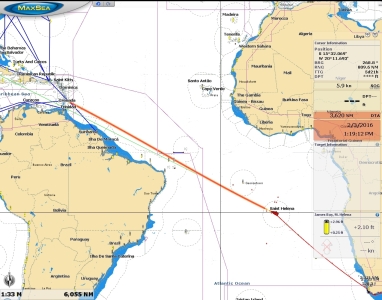 |
1/8/2016: 3,650 to Barbados
Position: -15°42.40'S, -6°11.38'W
We're underway now on our longest non-stop run so far: 3,650nm from St. Helena to Barbados. We left on the tail end of a high-pressure system and for the first 2-3 days expect 6-7ft seas on 7 seconds from behind. So far this has produced a comfortable maximum roll of around 10 degrees, with max pitch around 4 degrees. In about 3-4 days, the wave period should lengthen to about 10 seconds which should reduce roll and improve fuel economy. Our total fuel capacity is 2,707 gallons: 1747 in the internal tanks and 960 in fuel bladders on deck. Since fueling at St. Helena, the generator had consumed 16 gallons, so we departed with 2,691 gallons. So far we have averaged about 5.5 knots with a fuel economy of just under 1.6 nm/gallon. It's looking like this trip is going to be very nearly a month at sea.
|
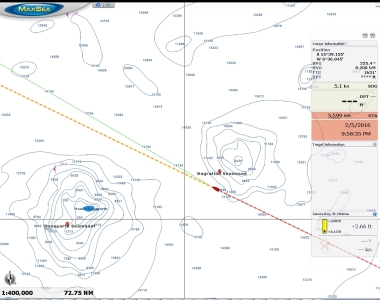 |
1/9/2016: Seamounts
Position: -15°33.34'S, -6°30.80'W
We're passing between Bagration Seamount to the north and Bonaparte Seamount to the south. From 14,000-ft depths, Bagration Seamount rises to about 4,000 feet below the surface, while Bonaparte Seamount is less than 350ft from the surface and is a popular fishing grounds for commercial boats from St. Helena. We saw several leave yesterday en route to fishs, but didn't pick up any vessels on radar as we passed by.
|
 |
1/9/2016: Eight-fish morning
Position: -15°24.63'S, -6°49.47'W
We found eight flying fish around the boat this morning.
|
 |
1/9/2016: Water leak
Position: -15°7.44'S, -7°26.37'W
We traced a water leak that was showing up in the engine room around the port stabilizer to the cockpit raw water washdown faucet. The faucet was leaking inside the port engine room air intake, flowing into a conduit that runs to the forward side of the fuel tanks, out the end of the conduit and dribbling down onto the end of the stabilizer, around the stabilizer and down into the forward bilge area. Fluids sure can take strange paths on boats, making leaks a real challenge sometimes to track down.
|
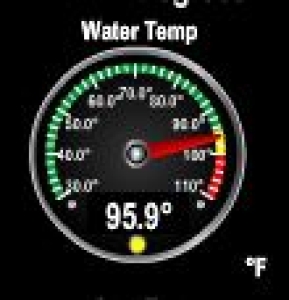 |
1/9/2016: 95.9
Position: -14°43.42'S, -8°17.79'W
The water is an incredibly warm 95.9°F
|
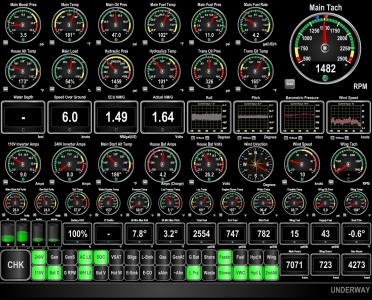 |
1/10/2016: Conditions
Position: -14°36.92'S, -8°31.69'W
Speed and fuel economy have been rather variable on the trip so far, particularly in the steeper waves. But the wave period is increasing a bit, and both fuel economy and speed are improving. We expect conditions will improve further in a couple of days from the already excellent conditions and this will continue to improve the fuel economy. We're carrying 15% of the boat's weight in fuel, and so as the fuel load goes down, fuel economy should improve slightly as well.
|
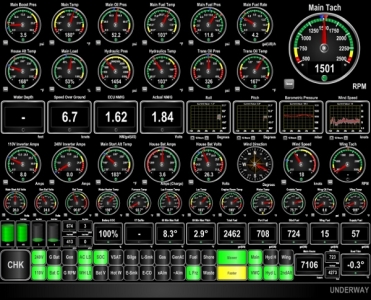 |
1/11/2016: Driving the lights
Position: -13°7.29'S, -11°36.86'W
We're "driving the lights" and just hit some positive current. Our fuel economy has increased to 1.84 nm/gallon (center of display), and the yellow indicator light at the bottom of the display indicates we can go faster and still meet our goal of 1.6nm/gallon. We actually need to attain only 1.5nm/gallon with 300 gallons of reserve, but are starting the trip a little conservatively and aiming for 400 gallons of reserve intitially. Conditions remain excellent, with 6-7ft seas on 7 seconds and 15-20kt winds, both from behind. We still expect conditions, and fuel economy, to improve slightly in a couple of days with the wave period increasing to 10-12 seconds, the wave height falling to 5-6ft, and winds dropping to around 10kts.
|
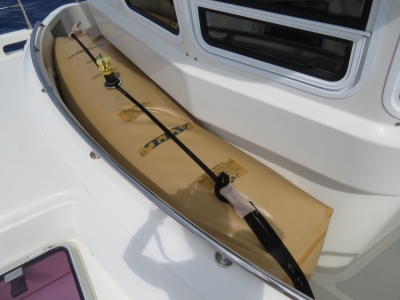 |
1/12/2016: 360 gallons down
Position: -11°35.29'S, -14°39.93'W
We've been at sea for four days now and at an average fuel economy of 1.63 nm/g have only consumed the amount of fuel carried in the 360-gallon forward bladder. The fuel in the picture is all we have burned so far. If we drained that bladder, the main tanks and the two 300-gallon cockpit bladders would still all be 100% full.
|
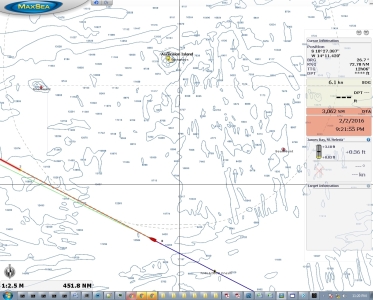 |
1/12/2016: Ascension Island
Position: -11°32.83'S, -14°44.69'W
It's just before midnight and we're about 200 miles directly south of Ascension Island. We've been asked why we didn't stop at Ascension on our way to Barbados. The short answer is the world is a big place and you can't stop everywhere. We needed to stop at Ascension or St. Helena for fuel. Fuel was easy to arrange in St. Helena and we had trouble getting data on fueling at Ascension. We could have fueled at St. Helena and stopped in Ascension but we didn't feel like the diversion. We had a really good time in St. Helena and felt ready to get underway on the long crossing.
|
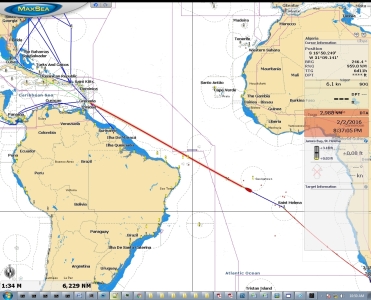 |
1/13/2016: 2,988 to go
Position: -10°57.95'S, -15°52.16'W
We just dropped below 3,000nm to go. There's still a lot of distance in front of us, but we're now just barely within the furthest distance we've traveled non-stop so far.
|
 |
1/13/2016: Conditions
Position: -10°39.03'S, -16°29.10'W
As the weather models indicated, the wave height has dropped slightly to around 5ft, the period has increased to over 10 seconds and winds are now 10-15 kts. This has had the expected impact on speed and fuel economy: we're now doing 7.6kts with a fuel economy of 1.62. We also are clearly getting help from a positive current. Also as expected, max roll has dropped to 5.6° in the past hour, and max pitch over tha period is 2.2°. Boat motion now is so minimal we can hardly tell we are at sea.
|
 |
1/13/2016: GMT-02
Position: -10°38.55'S, -16°30.05'W
The sun was setting around 8pm and it was still dark at 6am, so time to set the clocks back. We typically adjust the clocks in 2-hour increments on passages.
|
 |
1/13/2016: Levante
Position: -10°31.45'S, -16°43.69'W
The 620ft cargo ship Levante passed about two miles to our north tonight en route to Port Everglades, Florida. This is the first ship we've seen at sea since the Bomar Resilient over two weeks ago, before arriving at St. Helena, and only the second since leaving Cape Town over three weeks ago. As with the Bomar Resilient, we picked the Levante up on rader when it was over 24nm behind us.
|
 |
1/14/2016: Popcorn
Position: -9°58.25'S, -17°46.90'W
Air-popped popcorn makes an excellent on-watch late-night snack.
|
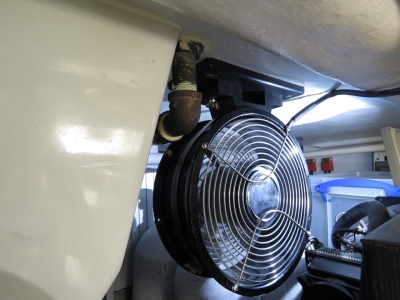 |
1/14/2016: Lazarette temperature
Position: -9°52.88'S, -17°57.05'W
The 110v inverter cut out today without indication of cause, but came back online a few minutes later. We suspect thermal overload caused the shutoff, as the inverter case was 114F in a 104F lazarette. We turned on the lazarette fan and the inverter case temperature dropped quickly to 106F while the laz temperature went down a degree to 103F. We’ll watch it, but we expect it’ll be fine with the fan on when the lazarette is up over 100F.
|
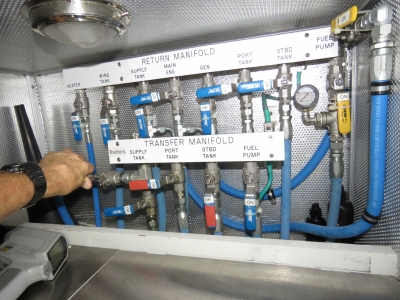 |
1/14/2016: Fuel manifold
Position: -9°52.83'S, -17°57.14'W
We've consumed about 500 gallons now so have more than enough space in the main fuel tanks to drain the 360-gallon forward bladder. The bladders are unstable when partially filled, so we won't drain one until we have enough space to hold the entire contents, with a good buffer for tank-level measurement error. Here we are opening the bladder valve at the fuel transfer manifold to begin the transfer. See Fuel for the Crossing for details of our fuel transfer process.
|
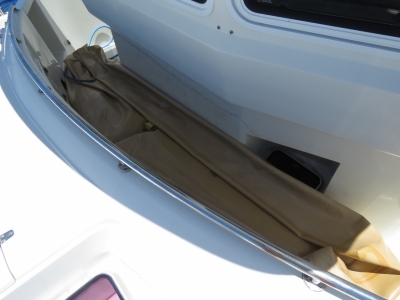 |
1/14/2016: Empty bladder
Position: -9°35.57'S, -18°29.66'W
The forward bladder is now completely drained and the main tanks are back to being almost full again.
|
 |
1/14/2016: Cleaning
Position: -9°30.36'S, -18°39.47'W
The bladder and the portuguese bridge were quite dirty with saltwater spray from the first few days out of Cape Town, dust from the big winds in St. Helena, and fish scales from two flying fish that had landed there. We laid the bladder out on the foredeck and Jennifer cleaned it while James scrubbed the portuguese bridge. Notice how calm the seas are, with only tiny wind waves disturbing the water surface.
|
 |
1/14/2016: Ready to stow
Position: -9°28.70'S, -18°42.60'W
The forward bladder folded up and ready to stow.
|
 |
1/14/2016: Stowing
Position: -9°28.30'S, -18°43.37'W
Sliding the forward bladder into storage in the flybridge brow. We're not sure when we'll use it again.
|
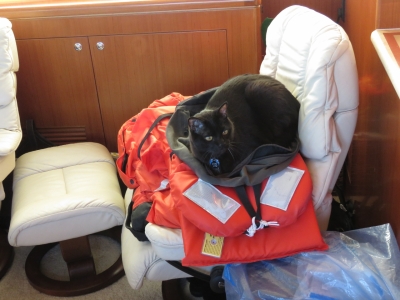 |
1/14/2016: Ditch bag
Position: -9°19.02'S, -19°0.83'W
Spitfire apparently had some safety concerns and is preparing to abandon ship. Here he is ready to go on his ditch bag: a knapsack secured to an offshore lifejacket to make a sort of raft. Underneath it are our two Mustang 2175 exposure suits.
|
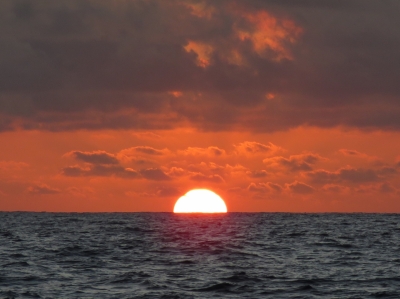 |
1/14/2016: Sunset
Position: -9°17.19'S, -19°4.28'W
We had a beautiful sunset tonight, with a major green flash as it set. Sunsets like these always remind us of our many sunsets watched from the Halekulani in Waikiki.
|
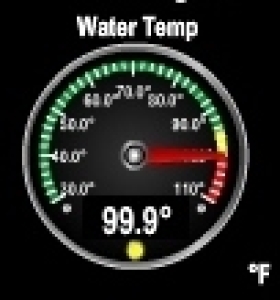 |
1/14/2016: 99.9
Position: -9°7.96'S, -19°22.01'W
The water temperature as we near the equator is an incredible 99.9°F--this is the most we've ever seen. A reading shortly after this had 100.0°F.
|
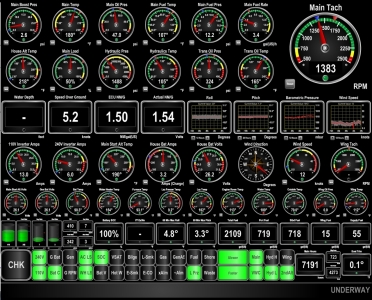 |
1/14/2016: Slow
Position: -9°5.67'S, -19°26.30'W
We've hit some major negative current and have reduced RPM to below 1,400 to continue to meet our fuel economy goal. we're only doing 5.2 kts now, at 1.54 nm/gal. The good news is that conditions are so calm, with max roll at 4.8° and max pitch at 3.3° over the past hour, that we hardly care about the speed. The boat is running well, and we're getting plenty of sleep and generally enjoying the trip. We'll just get there when we get there.
|
 |
1/15/2016: Muffins
Position: -8°52.03'S, -19°51.60'W
Fresh-baked chocolate chip muffins for breakfast.
|
 |
1/15/2016: Heading lost
Position: -8°38.97'S, -20°16.15'W
That red band across the top of the MaxSea display indicates heading data has been lost. Our SC-30 satellite compass stopped producing heading data a couple of times over the past day or so and it's starting to happen more frequently. This isn't a big deal from a navigation perspective as we can just flick a switch at the dash to change over to a solid-state compass for the autopilot heading to keep NAV mode functioning. Further investigation shows that the weather station is failing at the same time the SC-30 is losing heading information. Once in the past we had an SC-30 problem that ended up just being a NMEA 2000 network traffic pattern that it didn't like. That one was fixed by changing the transmission rate of the Maretron ACM100. So for this one, we know that it could just be the SC-30 not dealing well with current network traffic, or it could be the weather station failing, or it could be the SC-30 actually is having a problem itself. When you only have a fault every 4-6 hours, it's really a challenge to isolate the real problem.
|
 |
1/15/2016: Footprint boundary distance
Position: -8°23.70'S, -20°44.33'W
We're 192 miles from the coverage area for our of our always-on KVH mini-VSAT satellite data system. This is just under 1.5 days away at our current speed of 6 kts. We usually have to be well within the coverage area to actually connect, so we're expecting to be off BGAN and back on mini-VSAT in closer to two days. We're really looking forward to that. BGAN works well as a backup, but we really miss an always-on connection and, although no satellite data is cheap, few are as expensive as BGAN. Since leaving the mini-VSAT coverage area two weeks ago, all of our web site updates underway have been "blind", with minimally-sized images, to reduce data transfer costs. It will be nice to actually see the web site again, upload larger-resolution images, and re-enable automatic real-time position updates as well.
|
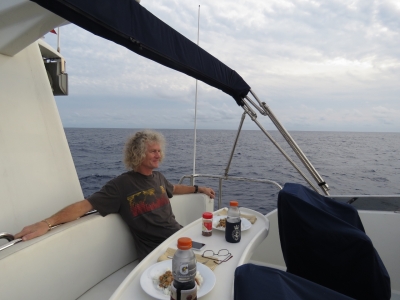 |
1/15/2016: Dinner
Position: -8°16.31'S, -20°57.95'W
Dinner on the flybridge as we enjoy the wonderfully calm conditions. The seas are amazingly smooth.
|
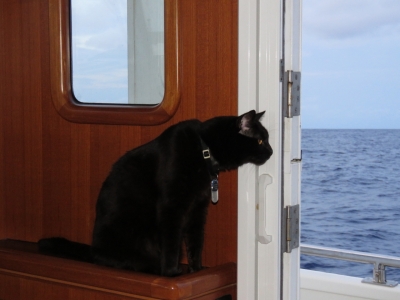 |
1/15/2016: Outside
Position: -8°14.39'S, -21°1.50'W
We usually have the doors shut and the A/C running, but have them open in the cooler evening. Spitfire spent about 10 minutes smelling outside from beside the door, then stood just outside the door for another 10 minutes trying to decide if he wanted to walk down to the cockpit. Possibly he still remembers the paw-soaking he got on the Indian Ocean crossing. He eventually decided on a shorter walk around the Portuguese bridge and back in the other door.
|
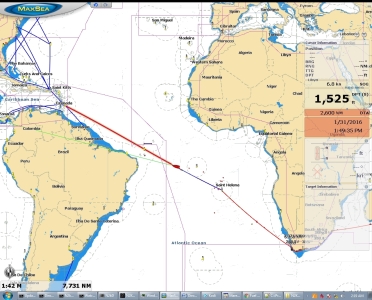 |
1/16/2016: 2,600 to go
Position: -8°0.30'S, -21°26.83'W
In the week since leaving St. Helena we've covered 1,050 miles and now are "only" 2,600 miles from Barbados. Since leaving Cape Town 3.5 weeks ago, we've travelled 2,763 miles. Our average speed on this leg from St. Helena has been 6kts with a fuel consumption of 662 gallons, yielding a fuel economy of 1.56nm/gallon. We've drained the 360-gallon forward deck bladder and are still carrying 2,029 gallons of diesel. We normally use a 200-300 gallon reserve, since we know the fuel levels on the boat fairly accuratetly. But on longer runs, with more potential for issue, we often at least start with greater reserves. With a 400-gallon reserve, we need to make 1.6nm/gallon. If we reduce the reserve to 300 gallons, we need to make 1.51nm/gallon.
|
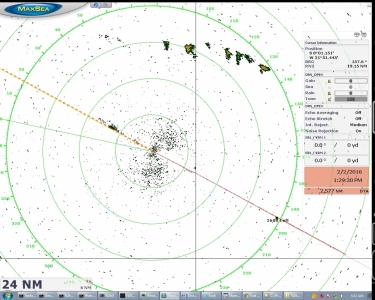 |
1/16/2016: Storm system
Position: -7°49.29'S, -21°47.18'W
A storm system is showing up clearly on the radar to the northeast and a smaller system is directly in front of us. If anything, these systems bring a bit of rain, but not much wind.
|
 |
1/16/2016: Ship
Position: -7°21.19'S, -22°39.41'W
We spotted another ship on radar today (the circled target to our SSW). It never got closer than about 17nm, so we didn't pick up an AIS transmission.
|
 |
1/16/2016: Weather station
Position: -7°19.00'S, -22°43.52'W
We're continuing to debug the intermittent SC-30 lost heading issue. It's challenging because it only happens a couple of times a day and, during those periods, it continues to send heading and position PGNs, but the heading PGNs have no data. The weather station is glitching at the same time, so here we are trying a spare weather station. It could be the weather station is faulting and causing the SC-30 to not send heading. Or it could be the SC-30 is faulting and causing the weather station to not send weather data. Or it could be unrelated to either one of them and the same external issue is causing intermittent failures on both these devices. The joys of debugging integrated electronics.
|
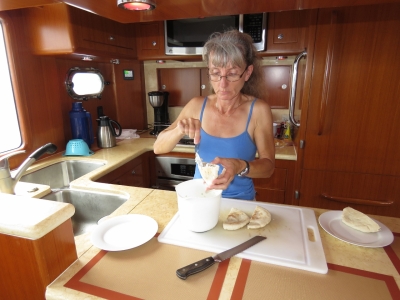 |
1/16/2016: Lunch
Position: -7°16.36'S, -22°48.56'W
Shrimp-salad pita pockets for lunch. The placemats on the counter are non-skid silicon baking mats. We use them throughout the galley, inside the micowave and on the pilothouse settee table to keep loose items from shifting when at sea. The mats look slightly better than the non-skid liner we use in our lockers, and are thin, so items can rest partway on the mat. See Heavy Weather Preparation for other preparations we make when going to sea.
|
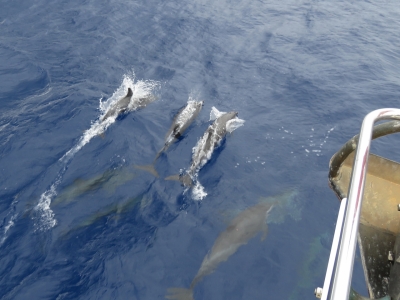 |
1/16/2016: Dolphins!
Position: -7°10.85'S, -22°58.53'W
A pod of perhaps 30 dolphins descended on the boat this afternoon and played in our bow wake, leaping and swerving. We spent ages enjoying the show.
|
 |
1/16/2016: Sunset
Position: -7°0.31'S, -23°17.15'W
Another beautiful sunset at sea.
|
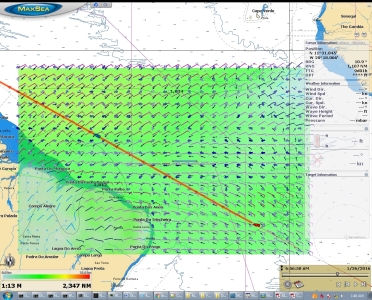 |
1/16/2016: Conditions
Position: -6°48.65'S, -23°37.74'W
Conditions remain excellent, with winds 10-15 from the SE, and boat roll and pitch as close to zero as you'll find in open ocean. Over the course of the past hour, the most we've seen from the "worst" wave is 3 degrees pitch and 5 degrees roll. And our speed has increased to 6 knots with a fuel economy of over 1.6m/gallon. Conditions should remain this way for the next week or so, but the weather models indicate they will deteriorate somewhat to 15-20-kt winds with 5-7ft seas on 7-8 seconds on the beam as we cross the equator and get into the northeast trade winds. The red boat icon shows our current position and the blue boat icon our expected location and weather for Jan 26th.
|
 |
1/17/2016: Booby prize
Position: -6°18.14'S, -24°34.07'W
Some boobies rode on Dirona last night and left us a present all over the flybridge and boat deck. Nice.
|
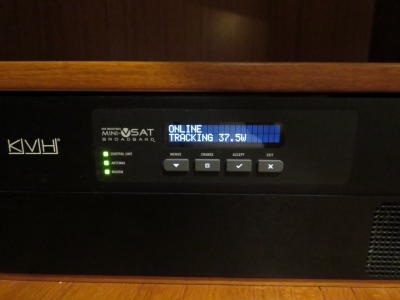 |
1/17/2016: Woohoo!!!
Position: -6°7.44'S, -24°53.45'W
We entered the coverage area for our of our always-on KVH mini-VSAT satellite data system yesterday and have been watching it try unsuccessfully to log on since. It connected just now and has been rock-solid ever since. It's sooo nice to have it back.
|
 |
1/17/2016: Laundry
Position: -5°58.50'S, -25°9.63'W
On the primary water tank, we carry 415 gallons. We only let it get down to 125 to 150 gallons before making water and filling it back up. If we have an uncorrectable water maker problem, we’ll still have more than 100 gallons of fresh water. On longer trips like this one, we’ll make water to refill at something closer to 200 gallons. Since laundry is a big water consumer, we often do it on the day we're replenishing the water tanks. Then we can flush the water maker and shut it down for a week or so before repeating.
|
 |
1/17/2016: 101 degrees
Position: -5°43.58'S, -25°36.58'W
The water temperature is an incredible 101°F.
|
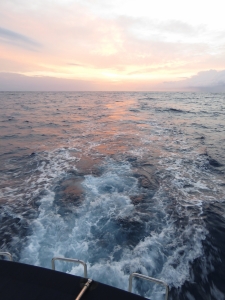 |
1/18/2016: Sunrise
Position: -5°18.78'S, -26°21.14'W
Sunrise with our wake trailing behind us. Conditions remain excellent, with average winds below 15kts.
|
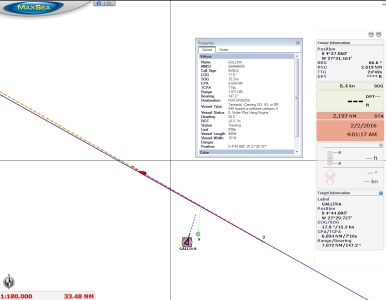 |
1/18/2016: Gallina
Position: -4°44.49'S, -27°22.37'W
The 955ft tanker Gallina passed about seven miles behind us heading north.
|
 |
1/18/2016: Wasabi salmon
Position: -4°41.52'S, -27°27.61'W
Sear-roasted Wasabi salmon for dinner. We're definitely not starving on this trip. :)
|
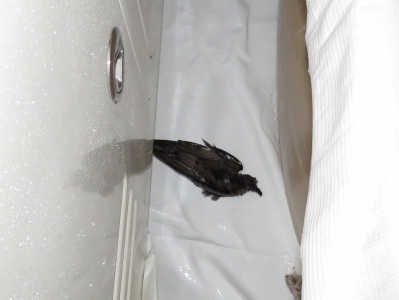 |
1/18/2016: Dead bird
Position: -4°38.26'S, -27°33.30'W
We found a dead bird between the starboard bladder and the cockpit propane locker. It may have hit the boat and died, or it could have just been sick and seeking shelter.
|
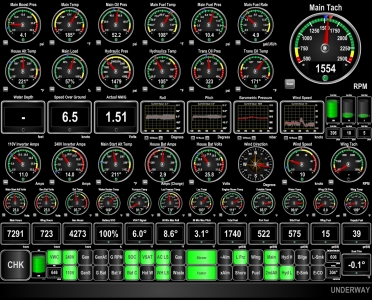 |
1/19/2016: Speed
Position: -4°14.25'S, -28°16.38'W
Our speed has been steadily above 6 kts at 1.5-1.6nm/g for the past day. Possibly we are getting into the South Equatorial Current that flows northwest along the northeast coast of South America. Sea conditions remain excellent with light winds. In the next couple of days, we still expect the wave period to begin to tighten from 10 to 7-8 seconds, and the wave height increase from 5ft to 7-8ft. This will coincide with a shift in wind and wave direction from SE to NE as we get into the NE trade winds.
|
 |
1/19/2016: Birds
Position: -4°0.42'S, -28°41.00'W
Now that we're running closer to shore, we're starting to see a lot more birds. Now if we can just get them to stop overnighting on the boat deck and burying it in bird guano, it would be ideal.
|
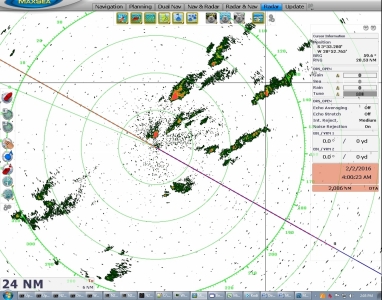 |
1/19/2016: Storms
Position: -3°50.01'S, -28°59.43'W
Several rainstorms rolled through this morning. It's the first significant rainstorm since before Cape Town.
|
 |
1/19/2016: Conditions
Position: -3°20.87'S, -29°50.95'W
The winds picked up to NE 20-25 today and the waves tightened, increasing max roll and pitch to a still-mild 10 and 9 degrees respectively. We thought that we were getting into the NE trades a little earlier than expected and that was the end of our calm conditions. But the winds settled back down to 10-15 and max roll and pitch over the past hour are back down to 6.6 and 4.4 degrees and have remained that way since. The wind spike and pitch spikes are particularly obvious on the 2nd row of the display, while roll increased and decreased more gradually.
|
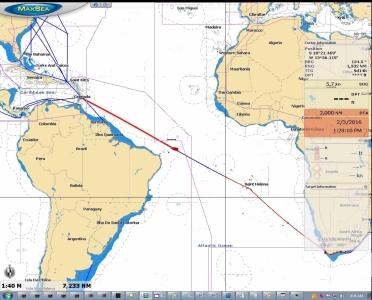 |
1/20/2016: 2,000nm
Position: -3°7.40'S, -30°14.78'W
We're still not halfway yet, but have only 2,000nm left to go. We remember leaving San Francisco for Hawaii on our first ocean crossing, a 2,000-mile trip. It seemed huge at the start and now 2,000 miles feels like we're close to done.
|
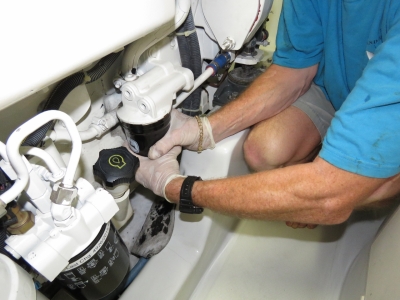 |
1/20/2016: Oil change
Position: -2°37.20'S, -31°9.79'W
This morning we slowed the boat down and transferred over to wing propulsion, moved the stabilizers over to wing power, and tried to find the calmest direction to run the boat. That was the little loop you can see in our track. Then we shut down the main engine and changed the main engine oil and filter. It took about 10 to 15 min and, once everything was back to normal and we were all cleaned up, we moved back to our original course. Read more ...
|
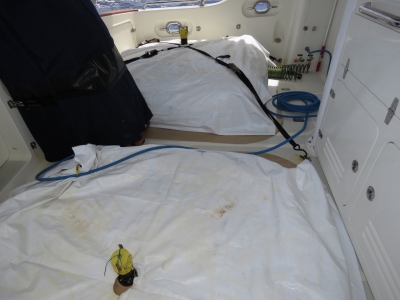 |
1/20/2016: Draining the bladders
Position: -2°31.39'S, -31°18.38'W
We've got enough space in the main tanks that we can drain the two 300-gallon cockpit bladders now. Here the port bladder is still full and we have almost emptied the starboard bladder. The drain hose runs from the valve at the left of the photo to the cockpit bulkhead fitting at the upper right. See Fuel for the Crossing for details of our fuel transfer process.
|
 |
1/21/2016: Ships
Position: -2°2.00'S, -32°10.12'W
Around 1am we passed two boats about 6 miles to port and could see a bright white light from one of them. Judging by their random speed and direction, both likely were fishing vessels. We also picked up an AIS target much further away that passed a good 20 miles behind us. It never got close enough for us to pick up any AIS detail.
|
 |
1/21/2016: Sink
Position: -1°39.12'S, -32°50.32'W
Spitfire is always adjusting his sleeping location. Here he is back in an old favourite: the master head sink. He frequently sleeps here in heavy weather. When conditions were consistently rough on our passage to the Marquesas, he pretty much lived there.
|
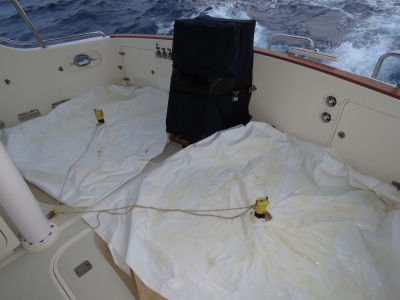 |
1/21/2016: Bladders empty
Position: -1°38.86'S, -32°50.78'W
We finished draining the bladders last night. All fuel now is below decks and our main tanks are close to full again.
|
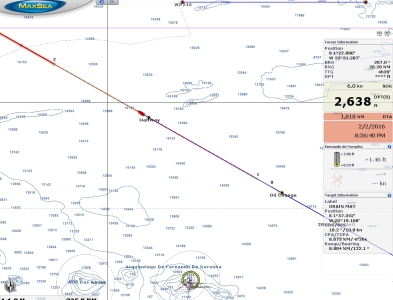 |
1/21/2016: Halfway
Position: -1°37.43'S, -32°53.28'W
We just passed the halfway mark of 1825 miles. It's all downhill from here.
|
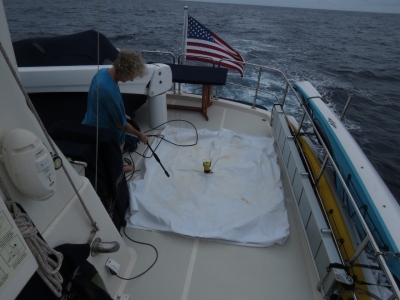 |
1/21/2016: Power wash
Position: -1°21.81'S, -33°20.73'W
We moved the boat deck table out of the way and brought the cockpit bladders up to power wash them clean before stowing them.
|
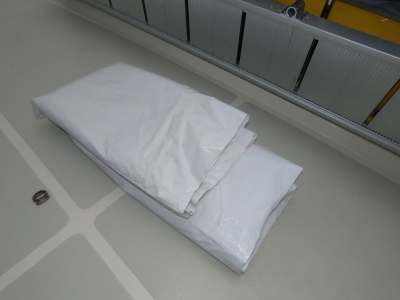 |
1/21/2016: Cleaned and folded
Position: -1°19.05'S, -33°25.57'W
One cockpit bladder, cleaned and folded and ready to stow. The cockpit bladders have white protective covers that we leave on when stowing to minimize sharp creases and also to protect the bladders from anything that might rub against them.
|
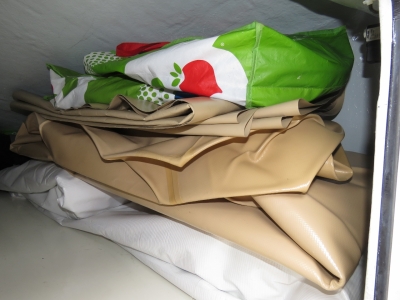 |
1/21/2016: Bladders stowed
Position: -1°17.69'S, -33°27.97'W
All three fuel bladders stowed in the flybridge brow. The two cockpit bladders are at the bottom and the forward bladder is on top. Above the bladders are thin plastic base pads for each bladder. At the very top, in the green Amazon Fresh bags, are the fuel transfer hoses.
|
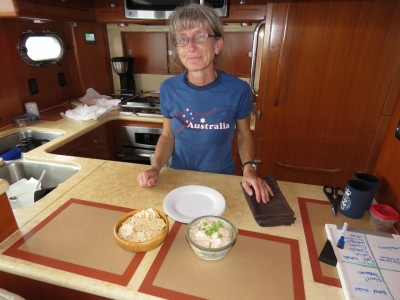 |
1/21/2016: Salmon dip
Position: -1°13.62'S, -33°35.13'W
Smoked salmon dip for lunch, made with fresh spring onions from Cape Town.
|
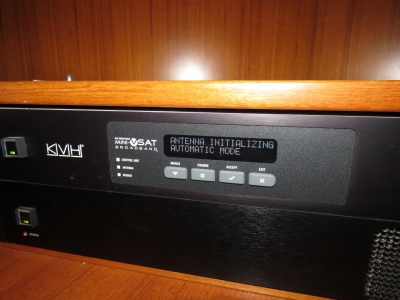 |
1/21/2016: Equatorial dead zone
Position: -1°9.06'S, -33°43.15'W
We've just hit the equatorial dead zone for our KVH mini-VSAT satellite data system. Our antenna, a KVH V7, cannot look skyward higher than 80 degrees. The only satellite in view from here is very near at 37W and, like all geosynchronous satellites, it flies directly over the equator. We are at 34W and also near the equator. Because the satellite is very nearly directly above us, we can't contact it. Using the official estimate of the no-coverage zone, we will be out again in 4 days. We think it might actually be a bit earlier if the boat motion isn't too much. For now we're back on BGAN :(.
|
 |
1/22/2016: Breaker panel
Position: 0°13.64'S, -35°20.38'W
Our pilothouse breaker panel is behind two plexiglass doors. The doors bend and flex in the heat, and one broke off today. We decided to just remove both and it both looks better and is much easier to access. We should have done that years ago.
|
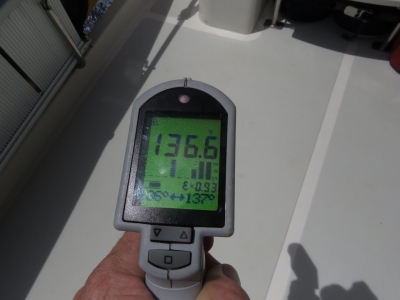 |
1/22/2016: Hot
Position: 0°4.78'S, -35°35.91'W
The boat deck is so hot from the sun we could hardly stand on it. A heat gun showed it at 136.6°F.
|
 |
1/22/2016: Equator
Position: 0°0.00'S, -35°44.30'W
We just crossed the equator and have returned back to the northern hemisphere after nearly three years away. This equator-crossing has been so much more comfortable than the north-to-south crossing, partly because conditions have been incredibly calm, but also because we can run the air conditioning 24x7 off the 240V inverter. We were really battling the heat on that passage to the Marquesas.
|
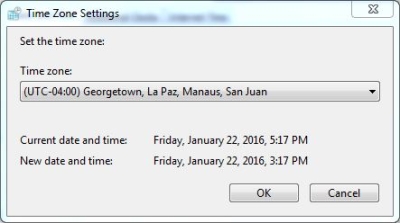 |
1/22/2016: Caribbean timezone
Position: 0°1.20'N, -35°46.41'W
We've changed the clocks back again and now are on Caribbean time. We're enjoying our passage, but definitely will be ready for a little "island time" when we get in.
|
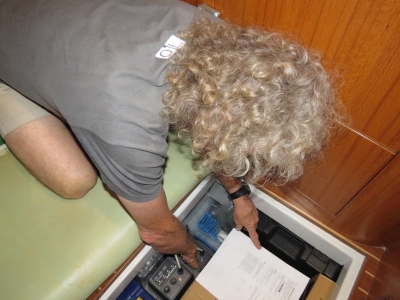 |
1/22/2016: PG-500
Position: 0°3.06'N, -35°49.73'W
James adjusting the autopilot compass heading to match the SC30's heading. This allows us a smoother transition to the satellite compass if the SC-30 loses heading. The SC-30 lost heading glitch is interesting. We initially thought it was a combined weather station and satellite compass problem, as wind data and heading went away at the same time. Both instruments are mounted at the top of the stack and connect to the NMEA 2000 bus through the same cabling, so this seemed plausible. But we later realized that we are displaying true wind direction, and heading is required to calculate that, so it's only the sat compass is at fault. The sat compass heading sensor is essentially two GPS receivers, where the location of each shows the direction. When one GPS fails, it'll have GPS but no heading, so possibly one of the GPSs is failing. Another possibility is that we once saw a case where legal data on the NMEA 2000 bus caused the sat compass problems and it went off line. At the time it was a Maretron ACM100 (alternating current monitor) sending data every 100 msec. We changed it to 1,000 msec and the sat compass was back to normal--an easy workaround. We're pretty sure there was nothing illegal in what the ACM100 was sending, but for some reason it causes the SC-30 problems when it was sent frequently. For the current lost heading issue, we found a protocol violation in something we were doing that's been there for years, so it is unlikely to be the cause of the problem. However the sat compass has worked without error for the past 36 hours. If it goes for something close to a week, we'll think we have it. At this point, we still suspect an internal problem in the sat compass but time will tell.
|
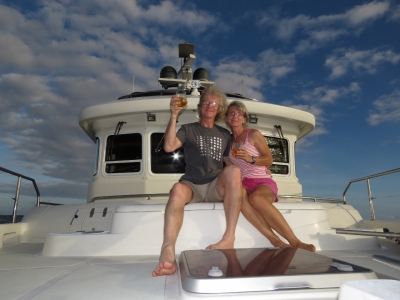 |
1/22/2016: Celebration
Position: 0°8.75'N, -35°59.63'W
A glass of sparkling cider to celebrate crossing the equator and passing the halfway mark on our 3,650nm passage.
|
 |
1/22/2016: Sunset
Position: 0°11.32'N, -36°4.15'W
Our first northern hemisphere sunset in nearly three years. Because we set the clocks back two hours to Barbados time, sunset was about 4:30, so we watched it from the flybridge before dinner.
|
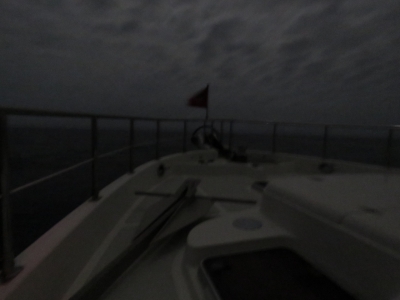 |
1/23/2016: Moonlight
Position: 0°29.44'N, -36°35.93'W
We're humming along at just over 6 knots with a bright moon lighting the foredeck. Conditions remain excellent, with the winds E-to-NE 10-15 knots and waves about 5ft on 7-8 seconds. We expect this to last about 2-3 more days and then we'll have 15-20 kt winds and 8 ft waves on 7 seconds, all from the NE, for most of the rest of the run as we get into the NE trade winds.
|
 |
1/23/2016: Hitckhiker
Position: 0°59.06'N, -37°27.91'W
A small crab has hitched a ride for the past few days, but disappeared soon after the bladders were stowed. We found a dead fish under one of the bladder covers, so perhaps it was eating that and once the food went way it abandoned ship.
|
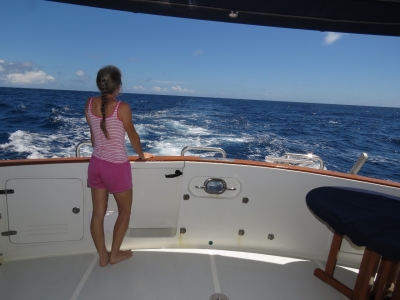 |
1/23/2016: Looking back
Position: 1°8.56'N, -37°44.60'W
Jennifer enjoying the view from the cockpit. It's great to have the bladders stowed and our cockpit back looking like normal again.
|
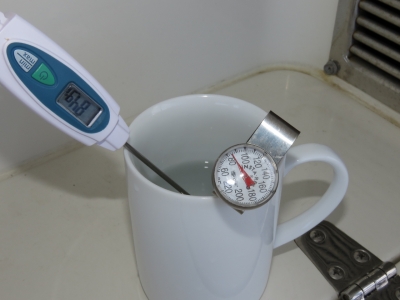 |
1/23/2016: Water temperature
Position: 1°11.66'N, -37°50.06'W
Even though we have two temperature sensors that both were reading 100°F, we had become suspcious of that number. So we dipped some saltwater off the back deck and measured the temperature using two different galley thermometers. Both read approximatly 85°F as did a heat gun measurement of the hull where one of the sensors is mounted. This is disappointing as it appears the water temperature has been wrong for a long time, perhaps upwards of a year. It's a reminder to all of us to not trust any sensor, chart, or instrument without verification. And, even with that verification, there is a tiny chance of it still being off. In this case the Maretron sensor which is the one we use and record, is reading 15°F high. The Furuno sensor shows 101F on the Furuno MFDBB display, but the NMEA 2000 PGN that it is sending is correct at 85F. So we appear to have a faulty instrument on the Maretron side and some sort of display bug in the Furuno MFDBB. We problably should change the Maretron sensor but for now, we put 15F of bias in it and will now use it as a backup sensor and switch over to using the Furuno sensor. We'll also setup an alert to flag whenever they differ.
|
 |
1/23/2016: Own dynamic data
Position: 1°14.66'N, -37°56.08'W
We had a few faults in the SC-30 satellite compass a couple of weeks back. They're now fixed and it's running like a champ. But we would like it to be the case that if the SC30- does fail, there's a lot less drama. Our backup is a Maretron GPS200 for position and SSC200 for heading. What we've done today is to make sure we can unplug the SC-30 and everything continues to operate without problem. Pictured is our AIS data that is sent to other ships--we're sending course, speed and position correctly with the SC-30 unplugged.
|
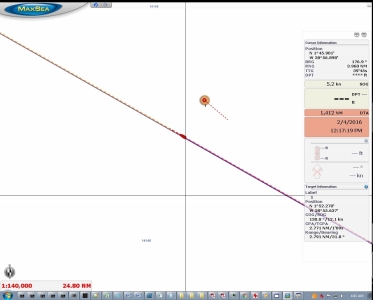 |
1/24/2016: Ship
Position: 1°49.90'N, -38°57.15'W
A large ship passed about 3 miles to our north around midnight. We could see it's deck lighs in the distance, but it was not transmitting AIS information.
|
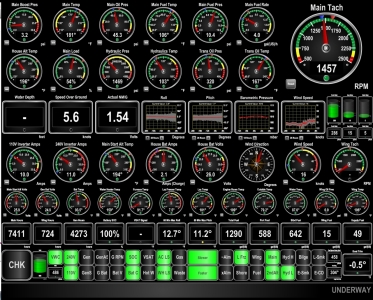 |
1/24/2016: Conditions
Position: 1°54.50'N, -39°5.22'W
As expected, the wind picked up to NE 20-30 earler today and the waves tightened to about 7-8ft on 7-8 seconds. Max roll and pitch over the past hour was 12.7° and 11.2° respectively. (The screenshot shows this data graphically for the past 24 hours in the third row). We've learned from experience that Jennifer will get seasick if we pitch steadliy over 10°, so she's wearing a scopolamine patch now. As the waves picked up, our speed fell and we were doing less than 5 knots to meet the fuel economy goal. So we reduced our fuel reserve from 400 to 300 gallons to allow us to run a little faster. This bought us a half to a full knot increase in speed.
|
 |
1/24/2016: Actuator
Position: 2°15.22'N, -39°47.29'W
Stabilizer actuators are wear items that ABT recommends replacing every 2,000 hours. This one failed in 1,000 hours, which is way too early. They should be able to go upwards of 3,000 hours. This is the failed actuator. Because it lasted roughly half of its expected lifetime, we're investigating possibly alignment issues, but haven't found any issues yet. Read more ...
|
 |
1/25/2016: Orange Ocean
Position: 3°31.79'N, -41°56.93'W
The unusually all-white 558ft Orange Ocean passed about five miles away heading to Newark.
|
 |
1/26/2016: Front Circassia
Position: 4°7.02'N, -42°59.43'W
The Front Circassia passed about 12 miles to our north just before midnight, but was too far away to see the navigation lights. The 1,098ft tanker was heading to Rio de Janeiro.
|
 |
1/26/2016: Kikyo
Position: 4°11.14'N, -43°6.75'W
The 738ft tanker Kikyo en route to Singapore passed about 5 miles away. Commercial traffic definaiely is picking up.
|
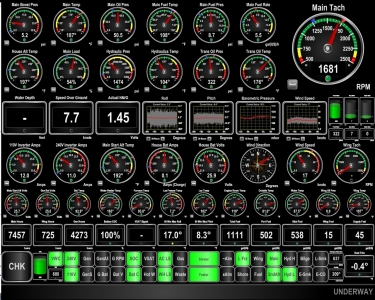 |
1/26/2016: 7.7 kts
Position: 4°12.29'N, -43°8.80'W
We're making unexepectedly good speed of 7.7 kts despite the conditions. We must be picking up a knot or so from the South Equatorial current.
|
 |
1/26/2016: Conditions
Position: 4°28.88'N, -43°38.38'W
We're in tight 9ft seas on 7 seconds and boat motion is pretty substantial. We're rolling steadily 20 degrees and just had one roll to 31.5°. The seas are so short and sharp that it's suprisingly difficult to move around in the boat and it's actually a bit unpleasant.
|
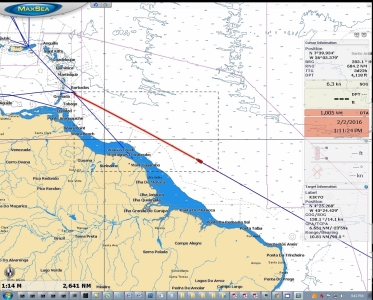 |
1/26/2016: 1,000 miles
Position: 4°57.54'N, -44°29.50'W
We're now within 1,000 miles of the Barbados coast.
|
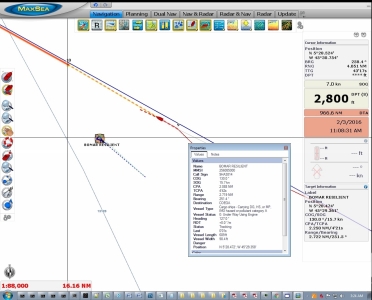 |
1/26/2016: Bomar Resilient
Position: 5°16.47'N, -45°3.28'W
The 689ft Bomar Resilient passed about two miles to our south carrying dangerous cargo bound for the port of Coega at Port Elizabeth, South Afrcia.
|
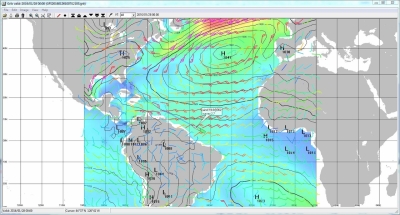 |
1/27/2016: High pressure system
Position: 5°29.95'N, -45°27.77'W
The rough seas we've been experiencing are partly due to our passing through the southern edge of a massive high pressure system that stretches across much of the northern Atlantic. We expect conditions to improve slightly in a day or so.
|
 |
1/27/2016: Slow
Position: 6°9.15'N, -46°38.36'W
We've hit an unexepcted negative current and have had to drop below 5 knots to maintain our fuel economy goal. The good news is that the seas are starting to settle down a bit. Maximum roll and pitch for the past hour have been 15.9 and 8.3 degrees respectively, down from 31.5 and 10.4 yesterday morning.
|
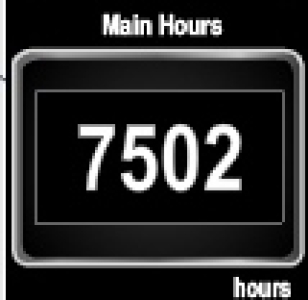 |
1/27/2016: 7,502 hours
Position: 6°23.87'N, -47°4.88'W
We just crossed 7,500 trouble-free hours on our John Deere main engine. The hours sure are winding on quickly--we left Darwin 5 months ago with only 5775 engine hours.
|
 |
1/28/2016: Bring out your dead
Position: 6°57.84'N, -48°6.32'W
Every morning James does a "bring out your dead" pass around the boat, throwing dead fish back into the ocean.
|
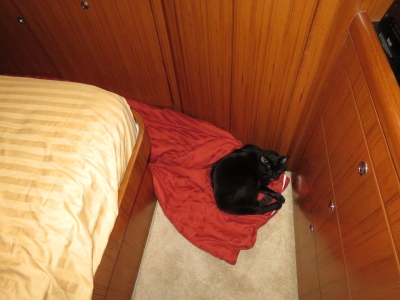 |
1/28/2016: Sleeping
Position: 7°3.42'N, -48°16.50'W
When conditions get rough, sleeping in the berth is difficult and sometimes even dangerous. We slide around too much on the berth and it keeps us awake, and James was once thrown off the berth in a particularly large roll. So when it's rough we sleep on the floor. Jennifer wedges into the walkway to port of the berth (pictured), and James sleeps on the opposite side on his off-watch shift. We sleep remarkably well this way, hardly waking up at all. Spitfire particularly likes Jennifer's side--he makes a little spot for himself at her feet and sleeps for ages.
|
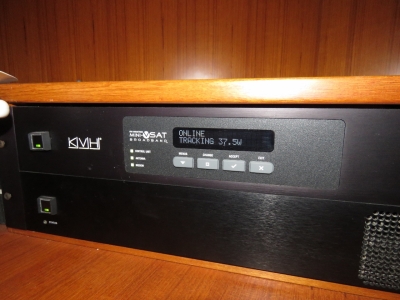 |
1/28/2016: Woohoo!!!
Position: 7°6.44'N, -48°22.05'W
After showing several different error messages and multiple reboots, our always-on KVH mini-VSAT satellite data system finally hooked up last night. We were well out of the equatorial dead zone when it did connect, so we anticipate there is some hardware issue.
|
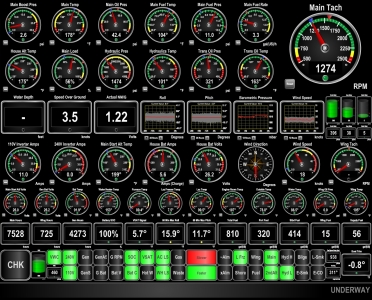 |
1/29/2016: Slow
Position: 7°27.68'N, -49°1.08'W
We continue to battle an unexpected negative current. Here we're doing only 3.5 knots and the "drive to the lights" indicator at the bottom center of the display says we must slow down even further to meet our fuel economy goal.
|
 |
1/29/2016: Course change
Position: 7°39.65'N, -49°23.10'W
Predicting how many days we have left is getting harder. Several times we have hit absolute brick wall currents. At one point we were slowed down to below 4 kts. We decided to allocate 100 gallons from the reserve to go a bit faster. We declared "success" on fuel a week ago and yet this morning we were back to talking about it and thinking that this current could actually make a massive safety margin look close if it continues unabated. We moved inland a bit looking for more favorable currents and are perhaps doing a bit better but we are running in the high 4 kts when we should be running in the 6 kts range. Overall, we are great on fuel but it's amazing what a major effect good or bad currents can have. It's one of the reasons it's hard to really know a boat's range — real world range changes so dramatically with environmental conditions.
|
 |
1/30/2016: Conditions
Position: 8°40.82'N, -51°32.83'W
We finally escaped the counter-current and now are making reasonable speed of over 6 kts again. We're still in 7-8ft seas on about 7 seconds with consistent rolls about 10° and the max roll over the past hour at 16.4°. Pitch has reduced slightly to under 10°. We expect these conditions for the rest of the way to Barbados.
|
 |
1/30/2016: Dolphins
Position: 8°58.10'N, -52°7.81'W
A big pod of dolphins put on a great show, leaping and twisting off our bow.
|
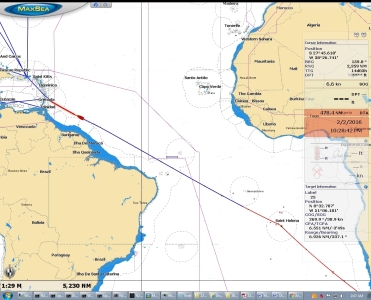 |
1/30/2016: Below 500 nm
Position: 9°3.61'N, -52°18.98'W
We've covered 3,172 nautical miles now, and have only 478 to go. We're getting close!
|
 |
1/30/2016: Speed
Position: 9°8.16'N, -52°28.22'W
Yesterday morning we were barely making 5 knots. This morning, with help froma positive current, we are averaging nearly 7 knots now while meeting our fuel economy goal.
|
 |
2/1/2016: Chartplotter
Position: 10°49.50'N, -55°42.45'W
At 257 miles out, we're close enough to show an outline of Barbados and our boat at the same time on the chartplotter.
|
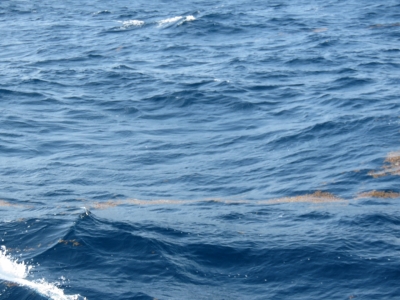 |
2/1/2016: Marine growth
Position: 10°59.63'N, -56°1.17'W
We passed quite a bit of near-shore marine growth over the past few hours, so we must be getting close to shore.
|
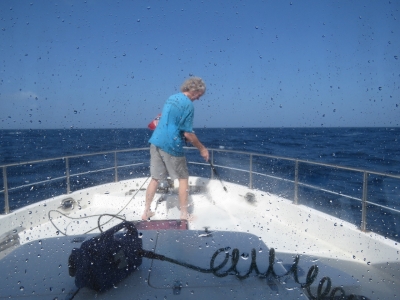 |
2/1/2016: Rinse
Position: 11°0.73'N, -56°3.21'W
We'll give the boat a good scrub when we get in, but for now James gave it a quick rinse with the powerwasher so we can move about and not get covered with salt. We also wanted to get some of the fish scales off before they became permanent.
|
 |
2/1/2016: Lettuce
Position: 11°17.61'N, -56°34.44'W
We still have fresh lettuce purchased from Cape Town six weeks ago. That Sub-Zero fridge really is impressive.
|
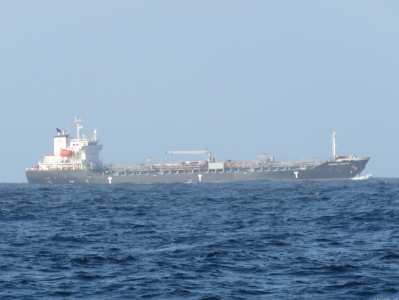 |
2/1/2016: Chembulk Houston
Position: 11°17.91'N, -56°34.99'W
The 443ft tanker Chembulk Houston passed about a mile and half to our north en route to Rio de Janeiro.
|
 |
2/1/2016: Deadline
Position: 11°22.91'N, -56°44.23'W
Our "driving the lights" program has two modes: one to meet a fuel economy goal and the second to meet a time-based deadline. At our current speed, we'll arrive just after sunset tomorrow. We'd rather not arrive in the dark and it will be difficult to speed up enough to ensure that we don't, so we've switched to deadline mode and slowed down to arrive first thing in the morning on the following day.
|
 |
2/2/2016: Conditions
Position: 11°53.12'N, -57°38.27'W
The winds have dropped to around 10 knots from the ENE and the seas have settled to a gentle swell on the stern quarter. The maximum roll and pitch for the past hour was 7.3° and 4.1° respectively. It's nice to be able to glide into our destination with such calm conditions.
|
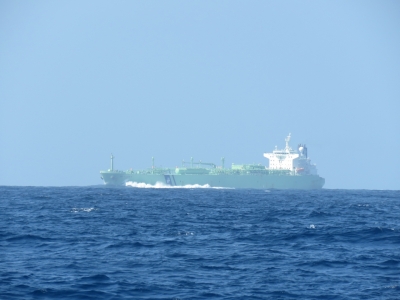 |
2/2/2016: BW Austria
Position: 12°8.62'N, -58°6.00'W
We passed another tanker today, the 741ft BW Austria, en route to Suape, Brazil. We seem to be on the oil tanker route to Brazil.
|
 |
2/2/2016: Fuel economy
Position: 12°17.62'N, -58°22.09'W
We're "driving the lights" to arrive tomorrow morning. We are currently burning 2.2 gallons/hour for an astonishing 3.2nm/gallons at 5.8kts. Conditions remain wonderfully calm.
|
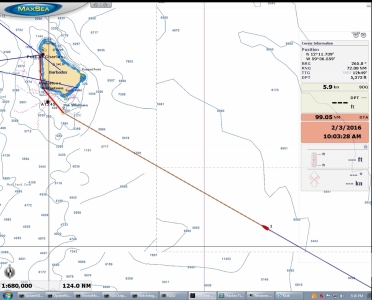 |
2/2/2016: Below 100
Position: 12°15.46'N, -58°18.21'W
3,551 miles down, 99 to go. We're within 100 miles of landfall now.
|
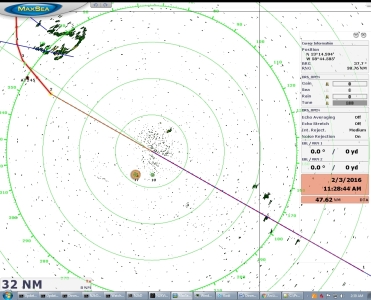 |
2/3/2016: Land ho!
Position: 12°43.74'N, -59°8.91'W
Barbados now is visible on radar 30 miles away.
|
 |
2/3/2016: Disney Wonder
Position: 13°6.53'N, -59°39.27'W
The cruise ship Disney Wonder was arriving into Barbados about the same time as we were. It reminded us a bit of the early-morning cruise ship arrivals we would see in our home port at Bell Harbor, Seattle.
|
 |
2/3/2016: Chassiron
Position: 13°6.66'N, -59°39.24'W
We changed course to give way to the small freighter Chassiron room to pass as it departed Bridgetown harbor.
|
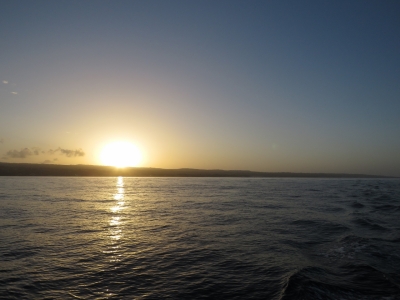 |
2/3/2016: Sunrise
Position: 13°12.59'N, -59°39.52'W
Our first ever Caribbean sunrise.
|
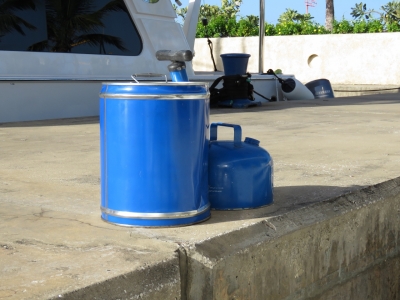 |
2/3/2016: Oil change
Position: 13°15.80'N, -59°38.67'W
Customs wouldn't be ready to clear is through for about an hour, so we changed the engine oil while we were waiting. This is our third oil change this calendar year and it's only February 3rd.
|
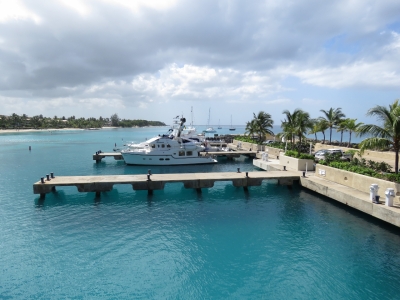 |
2/3/2016: Clearing through
Position: 13°15.82'N, -59°38.67'W
All the clearance officials were in a small building right on the docks. When they were ready for us, we just walked up there to handle the entrance formalities. This is the view from the immigration office to Dirona moored at Port St. Charles, Barbados.
|
 |
2/3/2016: Courtesy flag
Position: 13°15.80'N, -59°38.67'W
We got ourselves, the boat, and Spitfire all cleared through with Health, Immigration and Customs in about 15 minutes. We can now swap our yellow Q flag for a Barbados courtesy flag.
|